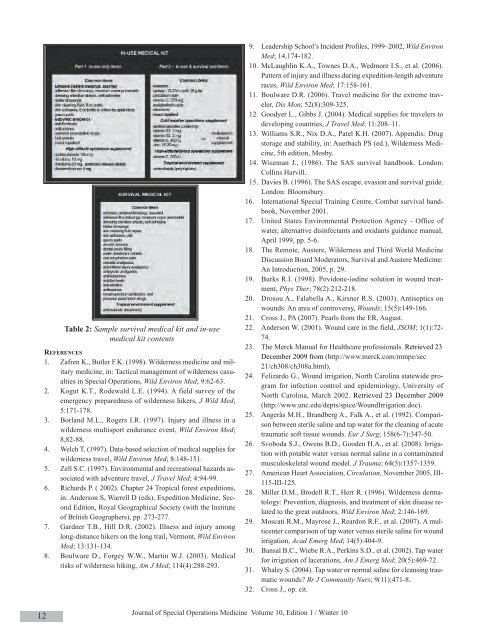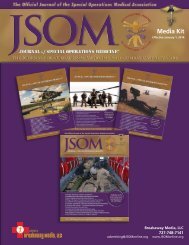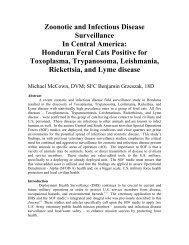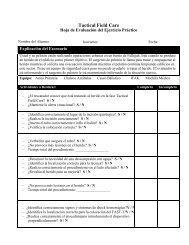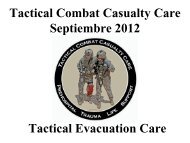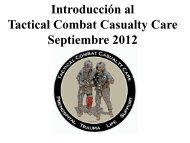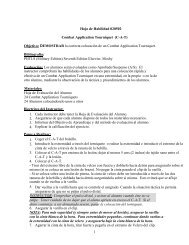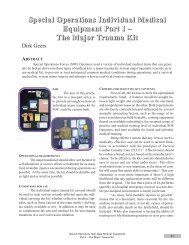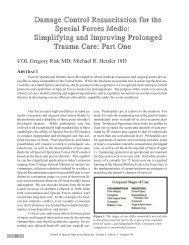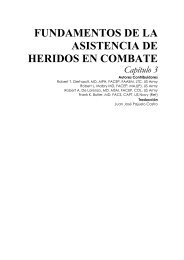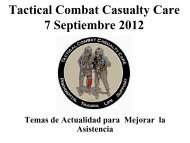Geers D. Special Operations Individual Medical Equipment Part 2
Geers D. Special Operations Individual Medical Equipment Part 2
Geers D. Special Operations Individual Medical Equipment Part 2
You also want an ePaper? Increase the reach of your titles
YUMPU automatically turns print PDFs into web optimized ePapers that Google loves.
Table 2: Sample survival medical kit and in-use<br />
medical kit contents<br />
REFERENCES<br />
1. Zafren K., Butler F.K. (1998). Wilderness medicine and military<br />
medicine, in: Tactical management of wilderness casualties<br />
in <strong>Special</strong> <strong>Operations</strong>, Wild Environ Med; 9:62-63.<br />
2. Kogut K.T., Rodewald L.E. (1994). A field survey of the<br />
emergency preparedness of wilderness hikers, J Wild Med;<br />
5:171-178.<br />
3. Borland M.L., Rogers I.R. (1997). Injury and illness in a<br />
wilderness multisport endurance event, Wild Environ Med;<br />
8,82-88.<br />
4. Welch T. (1997). Data-based selection of medical supplies for<br />
wilderness travel, Wild Environ Med; 8:148-151.<br />
5. Zell S.C. (1997). Environmental and recreational hazards associated<br />
with adventure travel, J Travel Med; 4:94-99.<br />
6. Richards P. ( 2002). Chapter 24 Tropical forest expeditions,<br />
in: Anderson S, Warrell D (eds), Expedition Medicine, Second<br />
Edition, Royal Geographical Society (with the Institute<br />
of British Geographers), pp. 273-277.<br />
7. Gardner T.B., Hill D.R. (2002). Illness and injury among<br />
long-distance hikers on the long trail, Vermont, Wild Environ<br />
Med; 13:131-134.<br />
8. Boulware D., Forgey W.W., Martin W.J. (2003). <strong>Medical</strong><br />
risks of wilderness hiking, Am J Med; 114(4):288-293.<br />
9. Leadership School’s Incident Profiles, 1999–2002, Wild Environ<br />
Med; 14,174-182.<br />
10. McLaughlin K.A., Townes D.A., Wedmore I.S., et al. (2006).<br />
Pattern of injury and illness during expedition-length adventure<br />
races, Wild Environ Med; 17:158-161.<br />
11. Boulware D.R. (2006). Travel medicine for the extreme traveler,<br />
Dis Mon; 52(8):309-325.<br />
12. Goodyer L., Gibbs J. (2004). <strong>Medical</strong> supplies for travelers to<br />
developing countries, J Travel Med; 11:208–11.<br />
13. Williams S.R., Nix D.A., Patel K.H. (2007). Appendix: Drug<br />
storage and stability, in: Auerbach PS (ed.), Wilderness Medicine,<br />
5th edition, Mosby.<br />
14. Wiseman J., (1986). The SAS survival handbook. London:<br />
Collins Harvill.<br />
15. Davies B. (1996). The SAS escape, evasion and survival guide.<br />
London: Bloomsbury.<br />
16. International <strong>Special</strong> Training Centre, Combat survival handbook,<br />
November 2001.<br />
17. United States Environmental Protection Agency - Office of<br />
water, alternative disinfectants and oxidants guidance manual,<br />
April 1999, pp. 5-6.<br />
18. The Remote, Austere, Wilderness and Third World Medicine<br />
Discussion Board Moderators, Survival and Austere Medicine:<br />
An Introduction, 2005, p. 29.<br />
19. Burks R.I. (1998). Povidone-iodine solution in wound treatment,<br />
Phys Ther; 78(2):212-218.<br />
20. Drosou A., Falabella A., Kirsner R.S. (2003). Antiseptics on<br />
wounds: An area of controversy, Wounds; 15(5):149-166.<br />
21. Cross J., PA (2007). Pearls from the ER, August.<br />
22. Anderson W. (2001). Wound care in the field, JSOM; 1(1):72-<br />
74.<br />
23. The Merck Manual for Healthcare professionals. Retrieved 23<br />
December 2009 from (http://www.merck.com/mmpe/sec<br />
21/ch308/ch308a.html).<br />
24. Felizardo G., Wound irrigation, North Carolina statewide program<br />
for infection control and epidemiology, University of<br />
North Carolina, March 2002. Retrieved 23 December 2009<br />
(http://www.unc.edu/depts/spice/WoundIrrigation.doc).<br />
25. Angerås M.H., Brandberg A., Falk A., et al. (1992). Comparison<br />
between sterile saline and tap water for the cleaning of acute<br />
traumatic soft tissue wounds. Eur J Surg; 158(6-7):347-50.<br />
26. Svoboda S.J., Owens B.D., Gooden H.A., et al. (2008). Irrigation<br />
with potable water versus normal saline in a contaminated<br />
musculoskeletal wound model. J Trauma; 64(5):1357-1359.<br />
27. American Heart Association, Circulation, November 2005, III-<br />
115-III-125.<br />
28. Miller D.M., Brodell R.T., Herr R. (1996). Wilderness dermatology:<br />
Prevention, diagnosis, and treatment of skin disease related<br />
to the great outdoors, Wild Environ Med; 2:146-169.<br />
29. Moscati R.M., Mayrose J., Reardon R.F., et al. (2007). A multicenter<br />
comparison of tap water versus sterile saline for wound<br />
irrigation, Acad Emerg Med; 14(5):404-9.<br />
30. Bansal B.C., Wiebe R.A., Perkins S.D., et al. (2002). Tap water<br />
for irrigation of lacerations, Am J Emerg Med; 20(5):469-72.<br />
31. Whaley S. (2004). Tap water or normal saline for cleansing traumatic<br />
wounds? Br J Community Nurs; 9(11):471-8.<br />
32. Cross J., op. cit.<br />
12<br />
Journal of <strong>Special</strong> <strong>Operations</strong> Medicine Volume 10, Edition 1 / Winter 10


